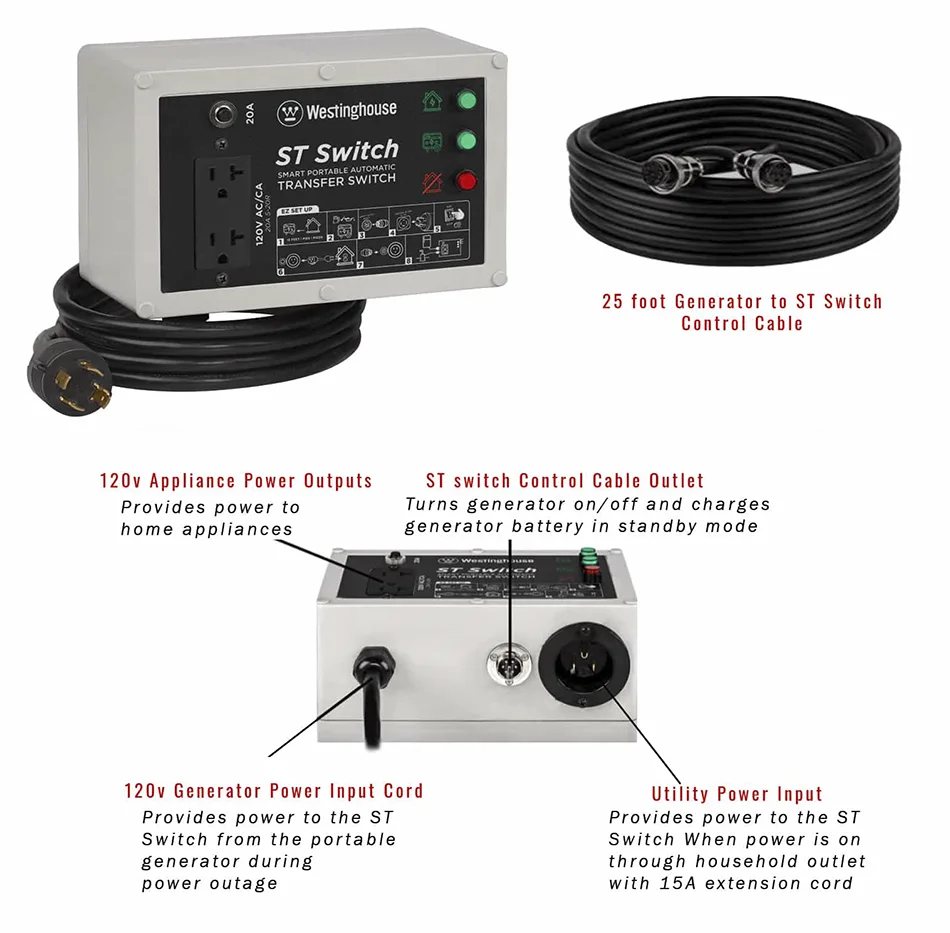
Written by Chris on March 21, 2023
Updated on: 20 July 2023
Portable Generators – Choosing and Connecting
Can a portable generator power a home? While they cannot really be compared with a “standby” generator, like this one made by Generac, they can go a long way to keeping your power on during any kind of incident in which the grid power goes down.

But this question is often asked by lots of people who worry about how to keep the power on for basic and essential equipment when the grid goes down.
And there is a good reason for this, especially if you live in an area like North Carolina or Vermont where winter storms and hurricanes have been the cause of multiple power outages. The summer of 2023 has also seen record-breaking temperatures across some parts of the US.
There are also some states, such as Massachusetts and West Virginia, that have heavily forested areas where outages are more commonly caused by falling trees and where heavy build-ups of ice eventually bring power lines down.
You can read about weather patterns and the hurricane season in our article on this subject.
Whether it’s actually worth getting a whole house generator is very much a personal choice. But there is no simple answer to whether a portable generator can power all your home because that depends on various factors. These include the size of your home and the kind of equipment and appliances you use under normal circumstances.
Also, portable generators are not designed to run 24/7, and even the biggest models cannot hope to be a complete replacement for your grid’s power.
Some manufacturers even warn owners about operating their generators for extended periods and how this can result in serious damage to the components. They advise that a dedicated static standby generator may be a better solution if you need 24/7 operation. Of course, these will cost you a lot more than a portable generator and you’ll find it much harder to take them with you if and when you move home.
Fortunately, not many homes need a 24/7 service because grid power is rarely off regularly and for long periods. And even in the rare and unusual case of a longer outage, owners are probably more cautious in their use of portable generators until grid power is restored.
What kind of portable generator is best for home use?

As we have noted elsewhere, there really is no such thing as the “best” generator which is often claimed by many sites on the internet.
However, assuming you will only need to power your home for limited periods when power outages occur, then the size of your portable generator will depend on how big your home is, where it’s located and the quantity of equipment and appliances you will want to power at various times. But remember, just like when the utility power is on, we never have everything on in our homes all drawing power at the same time, so a careful calculation is needed.
For starters, you will need to identify and list the power requirements of all your equipment and appliances you normally use day to day. With that information in hand, draw up various scenarios where different bits are connected. Again, bear in mind also your usage behavior during an emergency is likely to differ quite a lot from what you normally do.
Although listing all the power requirements may at first look like a daunting project, Champion Power Equipment have a great tool, Generator Selector – Champion Power Equipment, to help you calculate your power needs by providing examples of the power requirements of appliances and equipment generally found in homes.
Incidentally, Champion have one of the best websites for power generation equipment, including portable generators and fixed standby equipment. The information they provide is both consistent and clear.
However, what they do not appear to mention as of now is the need for you to consider the elevation of where you live when calculating how powerful your portable generator needs to be. We have written here about this, explaining some of the reasons why it’s necessary and offer pointers on how to go about it.
Bearing all of the above in mind, a portable generator capable of running a variety of appliances and equipment in and outside your home will likely have a running wattage of at least 7500 watts. And the best way of getting this kind of power into your home is through a transfer switch.
What is the most reliable whole house generator and what is the best brand?
Unfortunately, it’s not really possible to say definitively what is the most reliable portable generator capable of powering your whole house. The evidence suggests that if you are looking for a generator that is portable and able to power much of your house then your best bet is to go with one of the more powerful portable generators from an established brand, and buy it from a business with a good track record of dealing with customer returns. One such generator that might fit the bill is the DuroMax XP15000E, but it’s not the only one.
Connecting your portable generator to your home – Transfer Switches
So, the next thing you need to think about is how to connect the generator to your home using a transfer switch.
There are automatic and manual transfer switches on the market. But for a portable generator you typically need a manual switch. This is because a portable generator, by definition, is not usually connected permanently to a transfer switch. Instead, and when the need arises, you can connect the generator to the transfer switch, and then manually move the load over from utility power to generator power. (Westinghouse offer a dedicated automatic transfer switch, which you can see in our selection.)
Transfer switches are normally installed next to the utility panel and connected to a power inlet box outside containing an all-weather NEMA 3R plug. A suitable extension lead with twist-lock plugs makes the connection from the power inlet box to the generator, which should always be placed at a safe distance from your house. Overall, this kind of set up is called a power transfer system.
Some manual transfer switches have meters that show the wattage being used and which you can use to ensure that you are not overloading the system.
Is a Transfer Switch necessary?
Some states make it a legal obligation for you to have a transfer switch installed, while others strongly recommend it. Just keep in mind that many experts regard transfer switches as one of the most important accessories for a portable generator when considering the best method to safely power your home during an outage.
You will need to check about the legal requirements wherever you live but remember that the benefits of using a manual transfer switch far outweigh the cost.
What are the benefits of using a Transfer Switch?
While you can use a multitude of long extension cables running from the generator into your home to provide power, it is not the best way to go about it. Importantly, you cannot use pluggable extension cables to power 240v appliances and any other equipment that is hardwired, such as a well-pump. These must be fed through a transfer switch.
A transfer switch solves problems like these. It allows you to distribute power to essential electrical circuits providing you with utility-like power in the home for limited periods until grid power returns.
Furthermore, it prevents something called “backfeed” by isolating the generator’s electricity from the grid’s power lines. Backfeed occurs when the generator’s electrical power flows in reverse and into the grid when both the generator and the grid are supplying power simultaneously. This phenomenon has been known to seriously injure and kill power workers working on power lines. Follow this CDC link if you would like to learn more about this subject.
A transfer switch will also protect your home’s wiring from catching fire when utility power returns.
How much do Transfer Switches cost?
The best transfer switches can cost quite a lot of money with automatic switches normally costing the most. And as you may have gathered from our selection, manual varieties are not cheap either. Plus, you will have to take into account installation costs because, unless you really know what you are doing, a professional installation is needed for safety reasons, even if publicity suggests it’s an easy job. If in doubt, it’s far better to be safe rather than sorry by asking for professional advice.
Which is the best kind of Transfer Switch for my portable generator?
That depends on whether you already have a generator or are on the point of buying one.
If you already own a portable generator that has a 30 Amp plug, then you need a 30 Amp transfer switch. With a 50 Amp plug, you should get a 50 Amp transfer switch.
Before buying one make sure you have done your homework on power needs and understand the relationship between volts, amps, and watts. This link gives a pretty good explanation.
Transfer switches vary in the number of circuits they contain, and you could seek advice on how many you need to be wired to your utility panel.
With a more powerful generator of around 7500 running watts, you can generally choose a transfer switch that has between 6 and 10 circuits. With a less powerful generator you may only need a switch with 1 or 2 circuits. The thing to remember is to avoid overloading the generator by not selecting the right transfer switch and number of circuits for the size of your generator as this could end up in tears. Again, seek professional advice if in any doubt.
It’s worth mentioning that Westinghouse offer a dedicated Automatic Smart Transfer Switch with an innovative technology for some of their higher-powered models, such as the Westinghouse WGen9500. It offers the benefit of not needing an electrician for installation and will allow you to make full use of your generator to automatically transfer utility power into your home.

